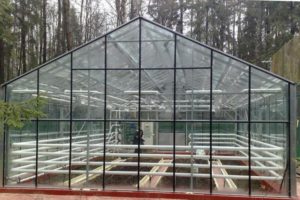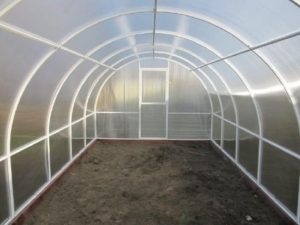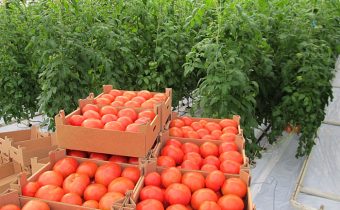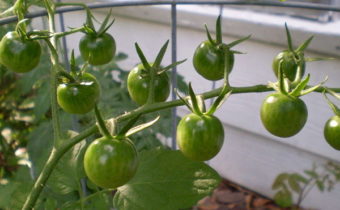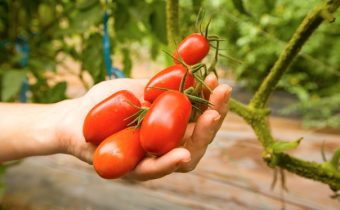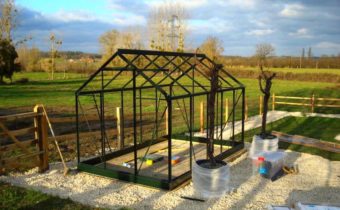Galvanized profile for greenhouse
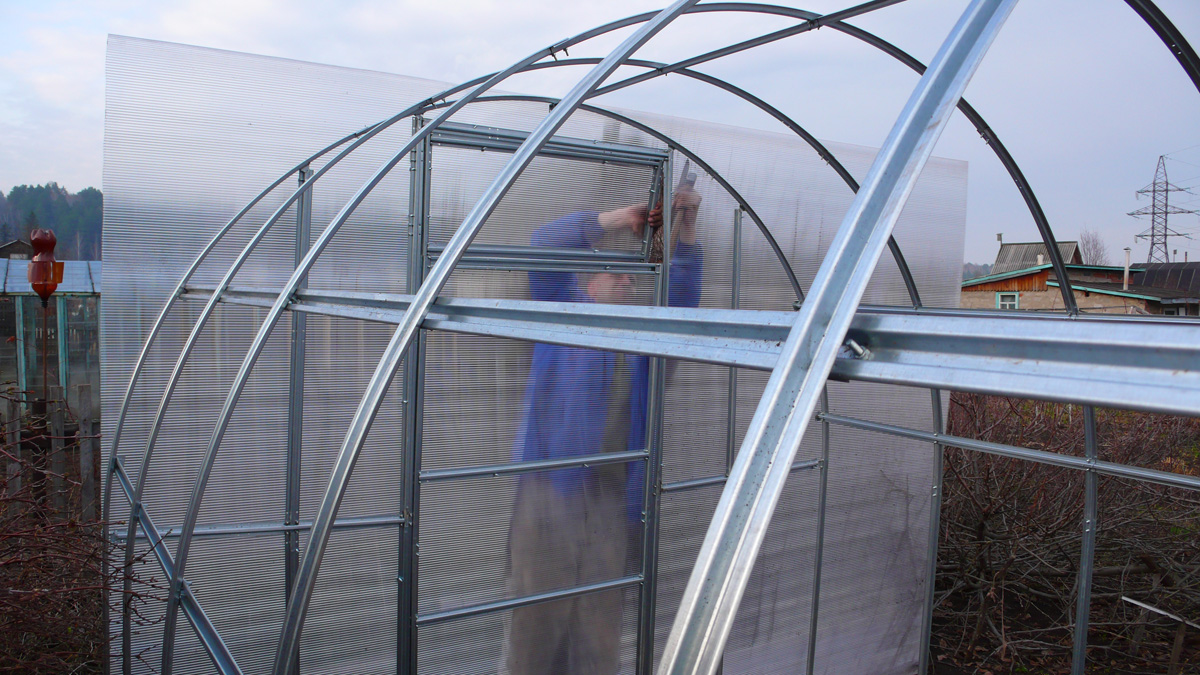
The strength of the greenhouse made of polycarbonate, its stability and durability are largely determined by the type of frame. The galvanized profile is highly valued and often used because it meets all standard requirements for structures of this kind. In their reviews, gardeners also note the ease of installation, affordable price, but they also talk about some of the shortcomings of the material.
Pros and cons
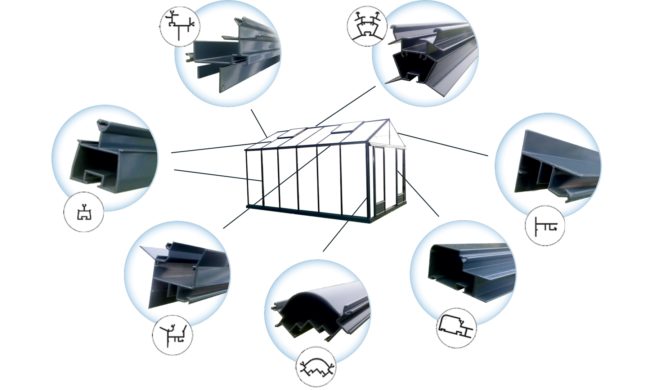
Galvanized metal is almost not afraid of corrosion, it does not require any additional coating, it does not need to be painted. For the greenhouse, which is constantly under the influence of climatic factors, this is important. Unlike other types of metal, steel with a zinc layer on top does not lose its properties for 10 years or more. The advantages also include:
- ease of installation;
- small weight;
- regular geometric shape;
- a variety of sizes.
In order to assemble a framework, a regular jigsaw or electric cutting tool, a set of self-tapping screws and a screwdriver are sufficient; it is not even necessary to know how to use welding. It is easy to transfer such greenhouse from a profile and polycarbonate to a new place and even completely to sort.
Stainless profiles are also durable, but their price is much higher, so for greenhouses it will not be rational to use.
As a disadvantage is called small carrying capacity. Permissible load on 1 square meter of the finished structure - 20 kilograms. Polycarbonate is lightweight, but in the winter, under the pressure of snow, the greenhouse may simply collapse. Therefore, you should consider in advance the angle of the slope of the roof or provide an arched structure. If the zinc layer is too thin, it is damaged, it can be broken off, in which case corrosion begins, painting of the whole element will be required.
Profile views
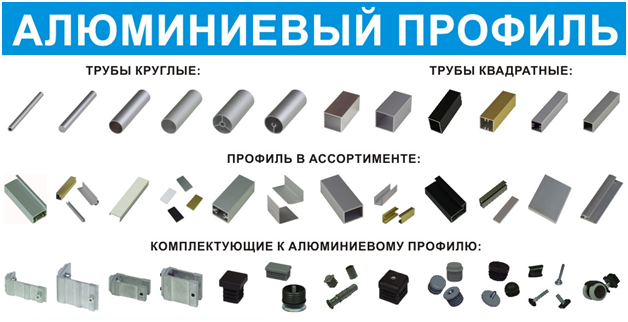
One of the new types of galvanized steel metal profiles is the omega structure. Their most common name is hat profiles. They have not a rectangular section, but a curved one, with an additional stiffener in the middle. Possible load increases at least three times, the frame is more rigid. For a greenhouse, there will be enough products with a thickness of 0.9 millimeters; for a large-sized capital greenhouse, it is better to use a foundation 1.5 millimeters thick. Such a profile is a bit more expensive, but even thickened polycarbonate can be attached to it.
Metal products differ in their section and size. The most popular types are 20x20 and 20x40 millimeters. The first type is lighter, suitable for very small greenhouses, but needs additional fixing on the ground. The rectangular profile is more convenient from the point of view of installation, well suited for the construction of long greenhouses, more stable.
Glass greenhouse do it yourself
Glass greenhouses - one of the most durable options. It is structurally more complicated than a simple greenhouse made of geofabric ...
Dual types of products are reinforced profiles that have an additional stiffener. Such are suitable for installation in the most difficult conditions: strong wind, waterlogging, a large amount of precipitation. This type is used for arranging capital, non-seasonal and not transportable greenhouses. The weight of the profile is much larger than the standard one, as is the price, but the total permissible load increases to 60 kilograms per square meter minimum.
Unclosed steel rolling is the most inexpensive, but also the most fragile. Square or rectangular cross-section makes it easy to mount the polycarbonate on the wall, but the overall stability is very small. This is a good option for mobile collapsible design, which is not used in late autumn and winter.
Strengthening an open profile with a base is meaningless and economically unprofitable.
W-shaped products, as well as angular ones, have an open circuit, therefore they are not too strong. They withstand the face and axial loads well, but are not suitable for all-season constructions. They can be used to strengthen individual sections, to partially restore, but not as the main material of the framework.
Metal products for plasterboard constructions can be found on sale. They are of two types: guides and rack. The latter can be the basis for the greenhouse, but for strength similar to an open view. Guide car can not be used for the installation of main walls and floors, it will not withstand even a small snow or wind load.
Frame assembly
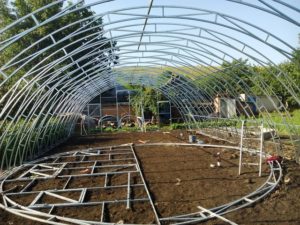
When choosing the type of metal products must take into account the characteristics of the greenhouse. Its height, size, type of roof, weight of material for plating. By drawing up a drawing, you can accurately calculate the amount of materials to be purchased. Therefore, all stages of further construction should be planned in advance.
The first stage is the formation of the end wall. First collect a rectangle, which should be at least 70 percent of the size of the entire greenhouse on each side. From the top edge they lay the perpendicular exactly in the middle, marking the starting point of the future ridge of the roof. An isosceles triangle with apex at the marked point is formed from the profile. Close to the corners drill small stiffeners. The assembly of the end wall is an important stage, since the distortions made now cannot be fixed. Immediately collect two opposite walls.
How to make a greenhouse from plastic pipes with their own hands
In stores for gardeners, you can find any ready-made greenhouse, but it does not always correspond to the wishes of people. By this…
The next stage is the installation of the main frame. Vertically set ends, propped up with temporary supports. The horizontal lines connect the extreme upper corners of the prepared walls. Then do the same below the contour of the future greenhouse. After starting to fill the future frame. With a step in the meter, the points of attachment of vertical supports are marked on the lower plank. When they are installed, all fasten the middle ridge. With the same gap, the pitched supports are attached to the upper rail of the future roof.
If an omega profile is used, only the classical gable assembly is possible, in all other cases it is permissible to create oval roofs and shapes, but in the absence of special tools this is difficult to do.
Additional stiffeners are needed if the greenhouse has a length of more than three standard meter spans. Also, this stage should not be missed if the climate is windy, snowy, the structure will have a serious load almost all year round. Reinforce the corners first, setting the strut with the mount at a point just below half the height of the side wall. If the profile is thin, additional edges should be created throughout the frame. In this case, the transverse roof bars additionally fasten horizontally in the middle of the length. Gains are attached to this bar. From the bottom they are screwed or welded to the bottom of the framework frame.
Installation of polycarbonate sheets start with the installation of plastic locks at the junction. Thus, exclude blowing, improve thermal insulation without additional materials. The first sheets are placed on the roof: they are inserted into the slots of the lock, screwed to the profile with special screws with plastic heads. The optimal screwing step is 400 millimeters.With such a drilling density, the risk of cracking is small, and the pressing density is maximum. Previously under the screws holes drilled. When all sheets are installed, it remains to remove the top cover of each lock, remove the film from the surface.
Using a galvanized profile as the basis of a polycarbonate greenhouse can significantly save on materials, while obtaining a durable construction. No need to paint or handle the frame annually, while it shows itself well even in the most difficult weather conditions. Compliance with the correct assembly sequence will allow you to build a greenhouse of any size with your own hands.

